Strategic Project Management Report: University of Central Lancashire
VerifiedAdded on 2023/01/23
|14
|6441
|23
Report
AI Summary
This report analyzes the strategic project management challenges and opportunities for Tyre & Wheel N S Pty Ltd, a subsidiary of a larger agro-industrial enterprise. The report addresses the company's poor performance, stemming from misaligned strategic visions between management levels and a lack of understanding of the company strategy among the workforce. The introduction provides context on the competitive and highly regulated automotive industry, highlighting factors such as trade protectionism, environmental regulations, and high costs. The report then introduces the Balanced Scorecard (BSC) as a tool to improve performance, examining its four perspectives: Financial, Customer, Internal Business Processes, and Learning and Growth. The analysis includes an industry overview of the Australian tire market, strategic considerations for the company, and a detailed breakdown of the BSC's application to improve the company's competitive advantage by considering factors like durability, quality, affordability, and service ability. The report concludes by outlining the importance of strategic leadership and the hierarchy of strategy, including corporate, business, and functional strategies.
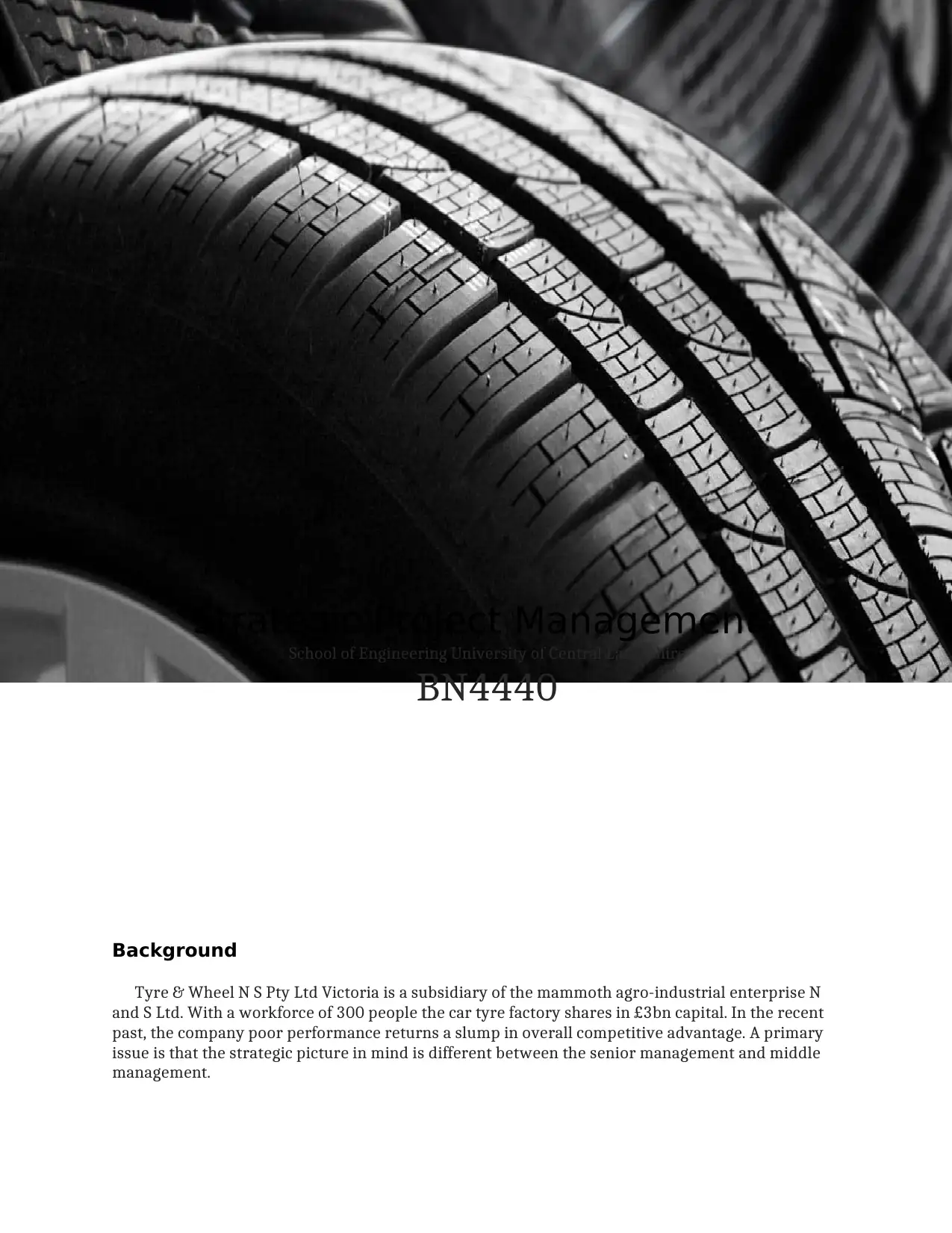
Strategic Project Management
School of Engineering University of Central Lancashire
BN4440
Background
Tyre & Wheel N S Pty Ltd Victoria is a subsidiary of the mammoth agro-industrial enterprise N
and S Ltd. With a workforce of 300 people the car tyre factory shares in £3bn capital. In the recent
past, the company poor performance returns a slump in overall competitive advantage. A primary
issue is that the strategic picture in mind is different between the senior management and middle
management.
School of Engineering University of Central Lancashire
BN4440
Background
Tyre & Wheel N S Pty Ltd Victoria is a subsidiary of the mammoth agro-industrial enterprise N
and S Ltd. With a workforce of 300 people the car tyre factory shares in £3bn capital. In the recent
past, the company poor performance returns a slump in overall competitive advantage. A primary
issue is that the strategic picture in mind is different between the senior management and middle
management.
Paraphrase This Document
Need a fresh take? Get an instant paraphrase of this document with our AI Paraphraser
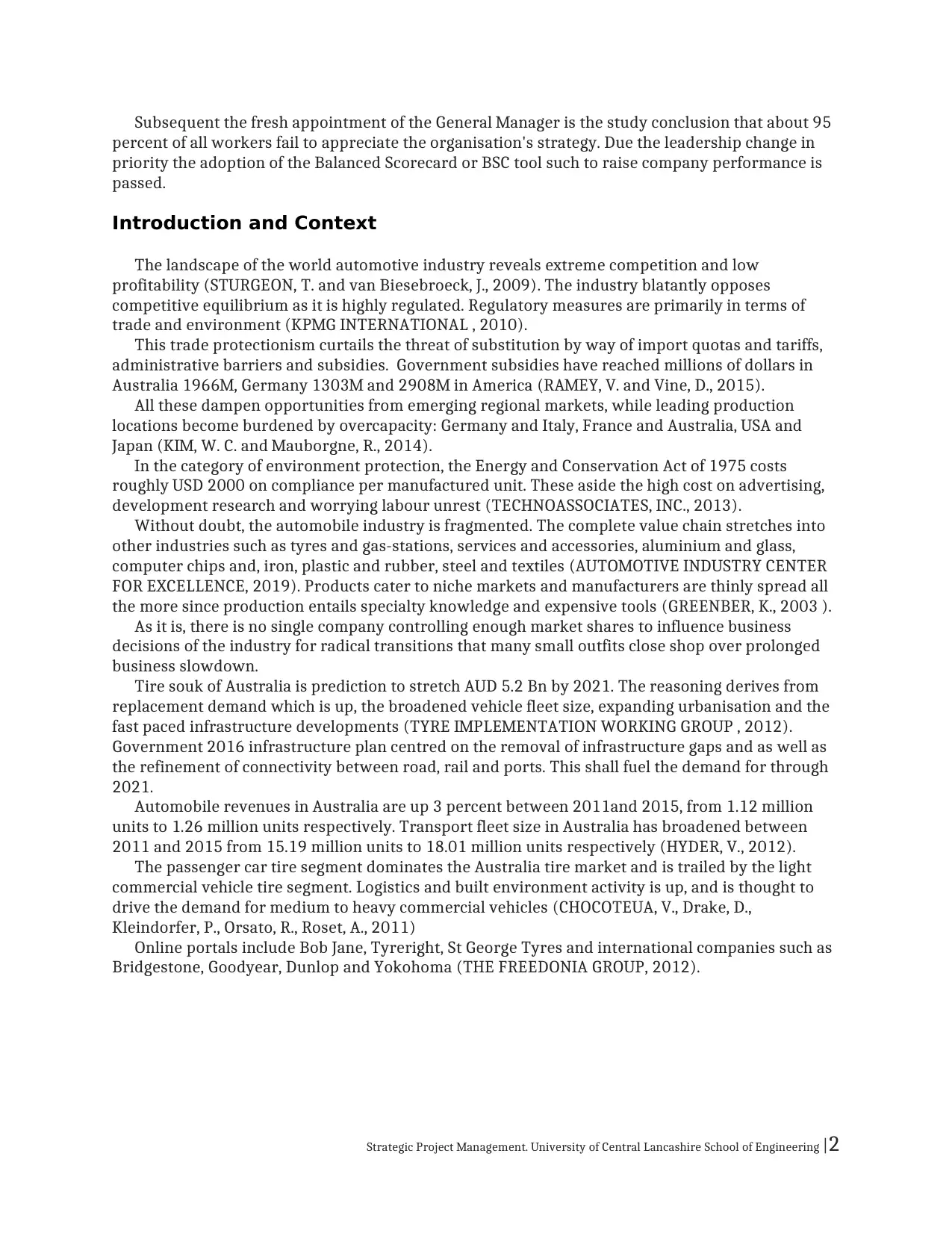
Subsequent the fresh appointment of the General Manager is the study conclusion that about 95
percent of all workers fail to appreciate the organisation's strategy. Due the leadership change in
priority the adoption of the Balanced Scorecard or BSC tool such to raise company performance is
passed.
Introduction and Context
The landscape of the world automotive industry reveals extreme competition and low
profitability (STURGEON, T. and van Biesebroeck, J., 2009). The industry blatantly opposes
competitive equilibrium as it is highly regulated. Regulatory measures are primarily in terms of
trade and environment (KPMG INTERNATIONAL , 2010).
This trade protectionism curtails the threat of substitution by way of import quotas and tariffs,
administrative barriers and subsidies. Government subsidies have reached millions of dollars in
Australia 1966M, Germany 1303M and 2908M in America (RAMEY, V. and Vine, D., 2015).
All these dampen opportunities from emerging regional markets, while leading production
locations become burdened by overcapacity: Germany and Italy, France and Australia, USA and
Japan (KIM, W. C. and Mauborgne, R., 2014).
In the category of environment protection, the Energy and Conservation Act of 1975 costs
roughly USD 2000 on compliance per manufactured unit. These aside the high cost on advertising,
development research and worrying labour unrest (TECHNOASSOCIATES, INC., 2013).
Without doubt, the automobile industry is fragmented. The complete value chain stretches into
other industries such as tyres and gas-stations, services and accessories, aluminium and glass,
computer chips and, iron, plastic and rubber, steel and textiles (AUTOMOTIVE INDUSTRY CENTER
FOR EXCELLENCE, 2019). Products cater to niche markets and manufacturers are thinly spread all
the more since production entails specialty knowledge and expensive tools (GREENBER, K., 2003 ).
As it is, there is no single company controlling enough market shares to influence business
decisions of the industry for radical transitions that many small outfits close shop over prolonged
business slowdown.
Tire souk of Australia is prediction to stretch AUD 5.2 Bn by 2021. The reasoning derives from
replacement demand which is up, the broadened vehicle fleet size, expanding urbanisation and the
fast paced infrastructure developments (TYRE IMPLEMENTATION WORKING GROUP , 2012).
Government 2016 infrastructure plan centred on the removal of infrastructure gaps and as well as
the refinement of connectivity between road, rail and ports. This shall fuel the demand for through
2021.
Automobile revenues in Australia are up 3 percent between 2011and 2015, from 1.12 million
units to 1.26 million units respectively. Transport fleet size in Australia has broadened between
2011 and 2015 from 15.19 million units to 18.01 million units respectively (HYDER, V., 2012).
The passenger car tire segment dominates the Australia tire market and is trailed by the light
commercial vehicle tire segment. Logistics and built environment activity is up, and is thought to
drive the demand for medium to heavy commercial vehicles (CHOCOTEUA, V., Drake, D.,
Kleindorfer, P., Orsato, R., Roset, A., 2011)
Online portals include Bob Jane, Tyreright, St George Tyres and international companies such as
Bridgestone, Goodyear, Dunlop and Yokohoma (THE FREEDONIA GROUP, 2012).
Strategic Project Management. University of Central Lancashire School of Engineering |2
percent of all workers fail to appreciate the organisation's strategy. Due the leadership change in
priority the adoption of the Balanced Scorecard or BSC tool such to raise company performance is
passed.
Introduction and Context
The landscape of the world automotive industry reveals extreme competition and low
profitability (STURGEON, T. and van Biesebroeck, J., 2009). The industry blatantly opposes
competitive equilibrium as it is highly regulated. Regulatory measures are primarily in terms of
trade and environment (KPMG INTERNATIONAL , 2010).
This trade protectionism curtails the threat of substitution by way of import quotas and tariffs,
administrative barriers and subsidies. Government subsidies have reached millions of dollars in
Australia 1966M, Germany 1303M and 2908M in America (RAMEY, V. and Vine, D., 2015).
All these dampen opportunities from emerging regional markets, while leading production
locations become burdened by overcapacity: Germany and Italy, France and Australia, USA and
Japan (KIM, W. C. and Mauborgne, R., 2014).
In the category of environment protection, the Energy and Conservation Act of 1975 costs
roughly USD 2000 on compliance per manufactured unit. These aside the high cost on advertising,
development research and worrying labour unrest (TECHNOASSOCIATES, INC., 2013).
Without doubt, the automobile industry is fragmented. The complete value chain stretches into
other industries such as tyres and gas-stations, services and accessories, aluminium and glass,
computer chips and, iron, plastic and rubber, steel and textiles (AUTOMOTIVE INDUSTRY CENTER
FOR EXCELLENCE, 2019). Products cater to niche markets and manufacturers are thinly spread all
the more since production entails specialty knowledge and expensive tools (GREENBER, K., 2003 ).
As it is, there is no single company controlling enough market shares to influence business
decisions of the industry for radical transitions that many small outfits close shop over prolonged
business slowdown.
Tire souk of Australia is prediction to stretch AUD 5.2 Bn by 2021. The reasoning derives from
replacement demand which is up, the broadened vehicle fleet size, expanding urbanisation and the
fast paced infrastructure developments (TYRE IMPLEMENTATION WORKING GROUP , 2012).
Government 2016 infrastructure plan centred on the removal of infrastructure gaps and as well as
the refinement of connectivity between road, rail and ports. This shall fuel the demand for through
2021.
Automobile revenues in Australia are up 3 percent between 2011and 2015, from 1.12 million
units to 1.26 million units respectively. Transport fleet size in Australia has broadened between
2011 and 2015 from 15.19 million units to 18.01 million units respectively (HYDER, V., 2012).
The passenger car tire segment dominates the Australia tire market and is trailed by the light
commercial vehicle tire segment. Logistics and built environment activity is up, and is thought to
drive the demand for medium to heavy commercial vehicles (CHOCOTEUA, V., Drake, D.,
Kleindorfer, P., Orsato, R., Roset, A., 2011)
Online portals include Bob Jane, Tyreright, St George Tyres and international companies such as
Bridgestone, Goodyear, Dunlop and Yokohoma (THE FREEDONIA GROUP, 2012).
Strategic Project Management. University of Central Lancashire School of Engineering |2
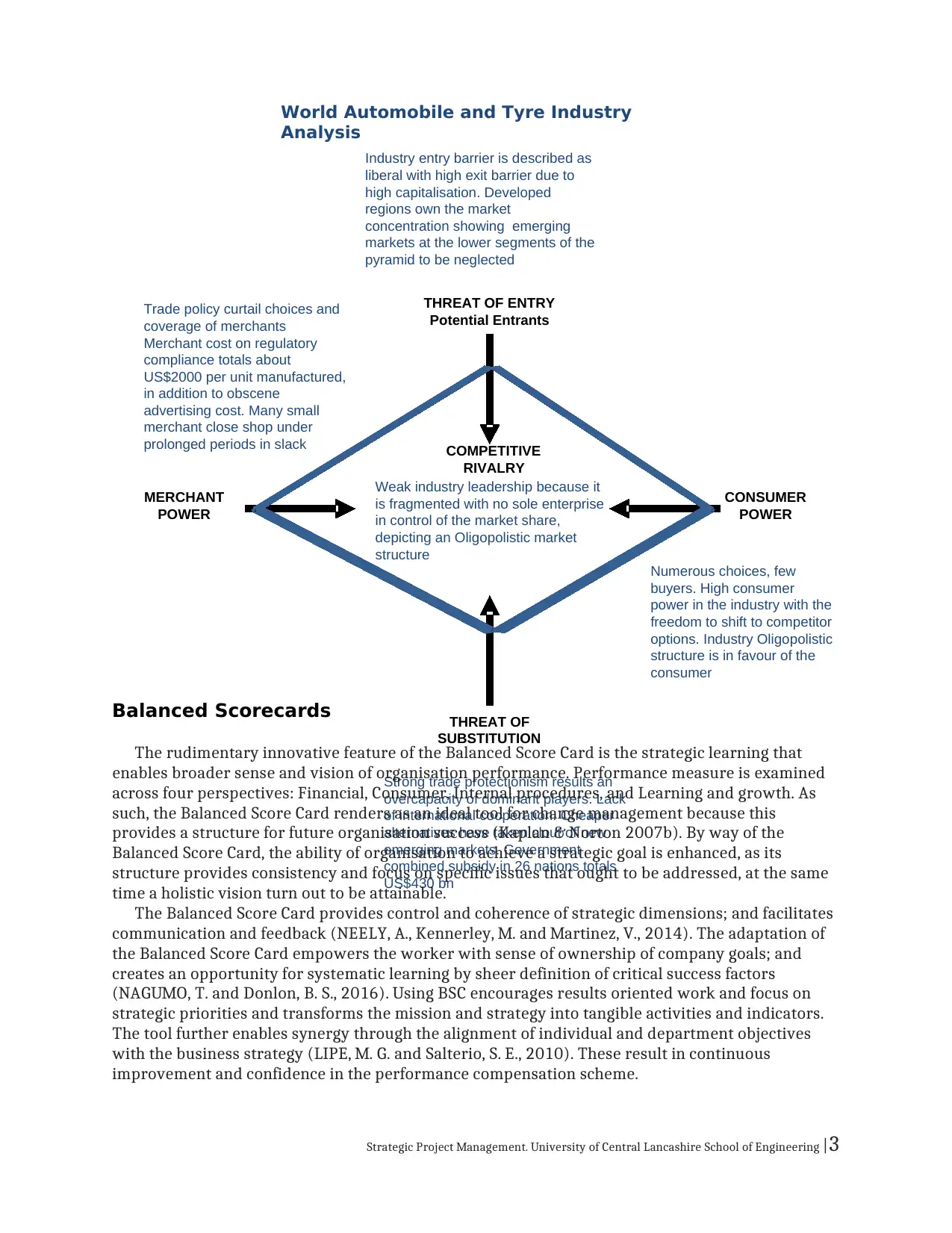
COMPETITIVE
RIVALRY
Weak industry leadership because it
is fragmented with no sole enterprise
in control of the market share,
depicting an Oligopolistic market
structure
THREAT OF ENTRY
Potential Entrants
Industry entry barrier is described as
liberal with high exit barrier due to
high capitalisation. Developed
regions own the market
concentration showing emerging
markets at the lower segments of the
pyramid to be neglected
CONSUMER
POWER
MERCHANT
POWER
THREAT OF
SUBSTITUTION
Numerous choices, few
buyers. High consumer
power in the industry with the
freedom to shift to competitor
options. Industry Oligopolistic
structure is in favour of the
consumer
Strong trade protectionism results an
overcapacity of dominant players. Lack
of international cooperation. Cheaper
alternatives have taken clout of new
emerging markets. Government
combined subsidy in 26 nations totals
US$430 bn
World Automobile and Tyre Industry
Analysis
Trade policy curtail choices and
coverage of merchants
Merchant cost on regulatory
compliance totals about
US$2000 per unit manufactured,
in addition to obscene
advertising cost. Many small
merchant close shop under
prolonged periods in slack
Balanced Scorecards
The rudimentary innovative feature of the Balanced Score Card is the strategic learning that
enables broader sense and vision of organisation performance. Performance measure is examined
across four perspectives: Financial, Consumer, Internal procedures, and Learning and growth. As
such, the Balanced Score Card renders as an ideal tool for change management because this
provides a structure for future organisation success (Kaplan & Norton 2007b). By way of the
Balanced Score Card, the ability of organisation to achieve a strategic goal is enhanced, as its
structure provides consistency and focus on specific issues that ought to be addressed, at the same
time a holistic vision turn out to be attainable.
The Balanced Score Card provides control and coherence of strategic dimensions; and facilitates
communication and feedback (NEELY, A., Kennerley, M. and Martinez, V., 2014). The adaptation of
the Balanced Score Card empowers the worker with sense of ownership of company goals; and
creates an opportunity for systematic learning by sheer definition of critical success factors
(NAGUMO, T. and Donlon, B. S., 2016). Using BSC encourages results oriented work and focus on
strategic priorities and transforms the mission and strategy into tangible activities and indicators.
The tool further enables synergy through the alignment of individual and department objectives
with the business strategy (LIPE, M. G. and Salterio, S. E., 2010). These result in continuous
improvement and confidence in the performance compensation scheme.
Strategic Project Management. University of Central Lancashire School of Engineering |3
RIVALRY
Weak industry leadership because it
is fragmented with no sole enterprise
in control of the market share,
depicting an Oligopolistic market
structure
THREAT OF ENTRY
Potential Entrants
Industry entry barrier is described as
liberal with high exit barrier due to
high capitalisation. Developed
regions own the market
concentration showing emerging
markets at the lower segments of the
pyramid to be neglected
CONSUMER
POWER
MERCHANT
POWER
THREAT OF
SUBSTITUTION
Numerous choices, few
buyers. High consumer
power in the industry with the
freedom to shift to competitor
options. Industry Oligopolistic
structure is in favour of the
consumer
Strong trade protectionism results an
overcapacity of dominant players. Lack
of international cooperation. Cheaper
alternatives have taken clout of new
emerging markets. Government
combined subsidy in 26 nations totals
US$430 bn
World Automobile and Tyre Industry
Analysis
Trade policy curtail choices and
coverage of merchants
Merchant cost on regulatory
compliance totals about
US$2000 per unit manufactured,
in addition to obscene
advertising cost. Many small
merchant close shop under
prolonged periods in slack
Balanced Scorecards
The rudimentary innovative feature of the Balanced Score Card is the strategic learning that
enables broader sense and vision of organisation performance. Performance measure is examined
across four perspectives: Financial, Consumer, Internal procedures, and Learning and growth. As
such, the Balanced Score Card renders as an ideal tool for change management because this
provides a structure for future organisation success (Kaplan & Norton 2007b). By way of the
Balanced Score Card, the ability of organisation to achieve a strategic goal is enhanced, as its
structure provides consistency and focus on specific issues that ought to be addressed, at the same
time a holistic vision turn out to be attainable.
The Balanced Score Card provides control and coherence of strategic dimensions; and facilitates
communication and feedback (NEELY, A., Kennerley, M. and Martinez, V., 2014). The adaptation of
the Balanced Score Card empowers the worker with sense of ownership of company goals; and
creates an opportunity for systematic learning by sheer definition of critical success factors
(NAGUMO, T. and Donlon, B. S., 2016). Using BSC encourages results oriented work and focus on
strategic priorities and transforms the mission and strategy into tangible activities and indicators.
The tool further enables synergy through the alignment of individual and department objectives
with the business strategy (LIPE, M. G. and Salterio, S. E., 2010). These result in continuous
improvement and confidence in the performance compensation scheme.
Strategic Project Management. University of Central Lancashire School of Engineering |3
⊘ This is a preview!⊘
Do you want full access?
Subscribe today to unlock all pages.

Trusted by 1+ million students worldwide
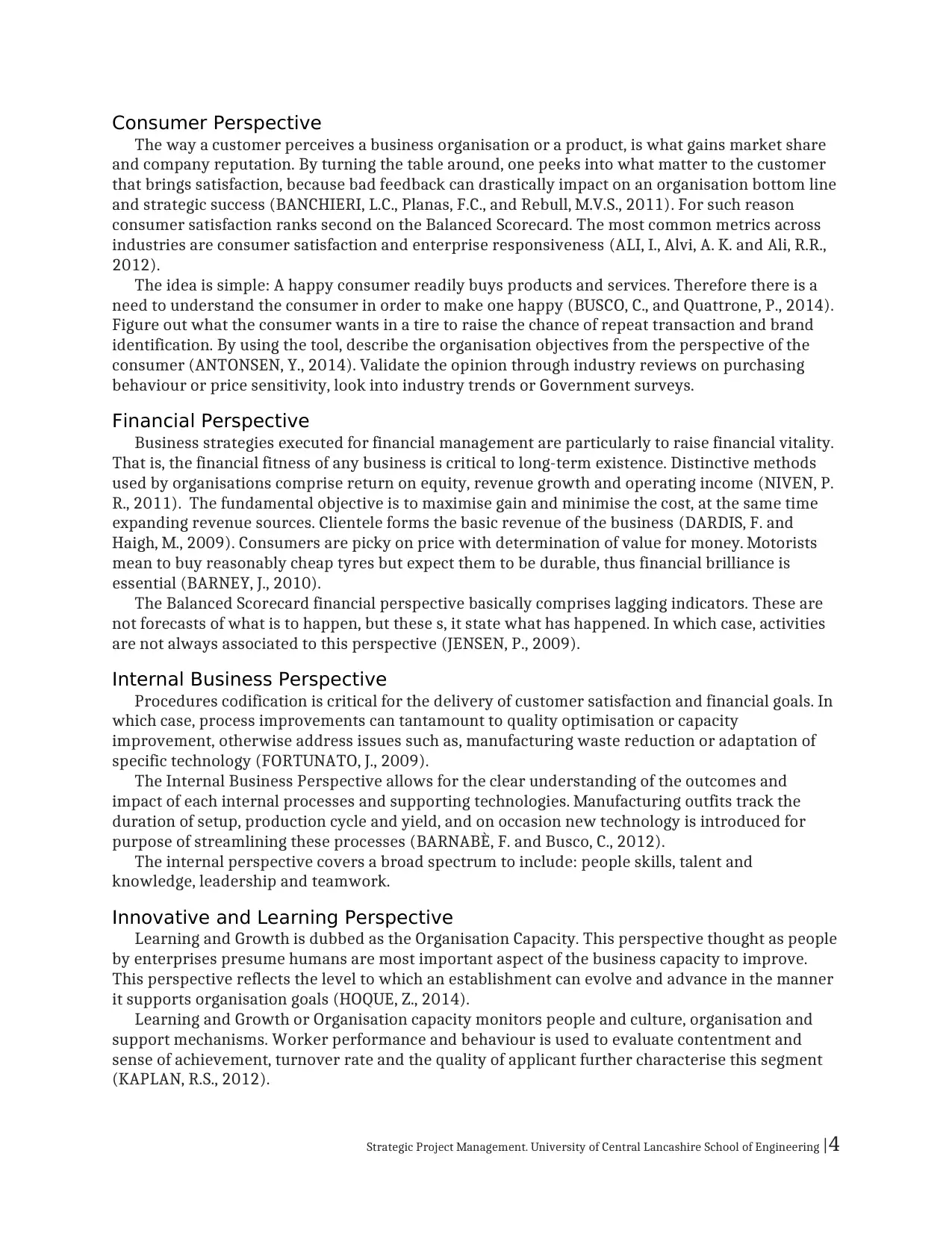
Consumer Perspective
The way a customer perceives a business organisation or a product, is what gains market share
and company reputation. By turning the table around, one peeks into what matter to the customer
that brings satisfaction, because bad feedback can drastically impact on an organisation bottom line
and strategic success (BANCHIERI, L.C., Planas, F.C., and Rebull, M.V.S., 2011). For such reason
consumer satisfaction ranks second on the Balanced Scorecard. The most common metrics across
industries are consumer satisfaction and enterprise responsiveness (ALI, I., Alvi, A. K. and Ali, R.R.,
2012).
The idea is simple: A happy consumer readily buys products and services. Therefore there is a
need to understand the consumer in order to make one happy (BUSCO, C., and Quattrone, P., 2014).
Figure out what the consumer wants in a tire to raise the chance of repeat transaction and brand
identification. By using the tool, describe the organisation objectives from the perspective of the
consumer (ANTONSEN, Y., 2014). Validate the opinion through industry reviews on purchasing
behaviour or price sensitivity, look into industry trends or Government surveys.
Financial Perspective
Business strategies executed for financial management are particularly to raise financial vitality.
That is, the financial fitness of any business is critical to long-term existence. Distinctive methods
used by organisations comprise return on equity, revenue growth and operating income (NIVEN, P.
R., 2011). The fundamental objective is to maximise gain and minimise the cost, at the same time
expanding revenue sources. Clientele forms the basic revenue of the business (DARDIS, F. and
Haigh, M., 2009). Consumers are picky on price with determination of value for money. Motorists
mean to buy reasonably cheap tyres but expect them to be durable, thus financial brilliance is
essential (BARNEY, J., 2010).
The Balanced Scorecard financial perspective basically comprises lagging indicators. These are
not forecasts of what is to happen, but these s, it state what has happened. In which case, activities
are not always associated to this perspective (JENSEN, P., 2009).
Internal Business Perspective
Procedures codification is critical for the delivery of customer satisfaction and financial goals. In
which case, process improvements can tantamount to quality optimisation or capacity
improvement, otherwise address issues such as, manufacturing waste reduction or adaptation of
specific technology (FORTUNATO, J., 2009).
The Internal Business Perspective allows for the clear understanding of the outcomes and
impact of each internal processes and supporting technologies. Manufacturing outfits track the
duration of setup, production cycle and yield, and on occasion new technology is introduced for
purpose of streamlining these processes (BARNABÈ, F. and Busco, C., 2012).
The internal perspective covers a broad spectrum to include: people skills, talent and
knowledge, leadership and teamwork.
Innovative and Learning Perspective
Learning and Growth is dubbed as the Organisation Capacity. This perspective thought as people
by enterprises presume humans are most important aspect of the business capacity to improve.
This perspective reflects the level to which an establishment can evolve and advance in the manner
it supports organisation goals (HOQUE, Z., 2014).
Learning and Growth or Organisation capacity monitors people and culture, organisation and
support mechanisms. Worker performance and behaviour is used to evaluate contentment and
sense of achievement, turnover rate and the quality of applicant further characterise this segment
(KAPLAN, R.S., 2012).
Strategic Project Management. University of Central Lancashire School of Engineering |4
The way a customer perceives a business organisation or a product, is what gains market share
and company reputation. By turning the table around, one peeks into what matter to the customer
that brings satisfaction, because bad feedback can drastically impact on an organisation bottom line
and strategic success (BANCHIERI, L.C., Planas, F.C., and Rebull, M.V.S., 2011). For such reason
consumer satisfaction ranks second on the Balanced Scorecard. The most common metrics across
industries are consumer satisfaction and enterprise responsiveness (ALI, I., Alvi, A. K. and Ali, R.R.,
2012).
The idea is simple: A happy consumer readily buys products and services. Therefore there is a
need to understand the consumer in order to make one happy (BUSCO, C., and Quattrone, P., 2014).
Figure out what the consumer wants in a tire to raise the chance of repeat transaction and brand
identification. By using the tool, describe the organisation objectives from the perspective of the
consumer (ANTONSEN, Y., 2014). Validate the opinion through industry reviews on purchasing
behaviour or price sensitivity, look into industry trends or Government surveys.
Financial Perspective
Business strategies executed for financial management are particularly to raise financial vitality.
That is, the financial fitness of any business is critical to long-term existence. Distinctive methods
used by organisations comprise return on equity, revenue growth and operating income (NIVEN, P.
R., 2011). The fundamental objective is to maximise gain and minimise the cost, at the same time
expanding revenue sources. Clientele forms the basic revenue of the business (DARDIS, F. and
Haigh, M., 2009). Consumers are picky on price with determination of value for money. Motorists
mean to buy reasonably cheap tyres but expect them to be durable, thus financial brilliance is
essential (BARNEY, J., 2010).
The Balanced Scorecard financial perspective basically comprises lagging indicators. These are
not forecasts of what is to happen, but these s, it state what has happened. In which case, activities
are not always associated to this perspective (JENSEN, P., 2009).
Internal Business Perspective
Procedures codification is critical for the delivery of customer satisfaction and financial goals. In
which case, process improvements can tantamount to quality optimisation or capacity
improvement, otherwise address issues such as, manufacturing waste reduction or adaptation of
specific technology (FORTUNATO, J., 2009).
The Internal Business Perspective allows for the clear understanding of the outcomes and
impact of each internal processes and supporting technologies. Manufacturing outfits track the
duration of setup, production cycle and yield, and on occasion new technology is introduced for
purpose of streamlining these processes (BARNABÈ, F. and Busco, C., 2012).
The internal perspective covers a broad spectrum to include: people skills, talent and
knowledge, leadership and teamwork.
Innovative and Learning Perspective
Learning and Growth is dubbed as the Organisation Capacity. This perspective thought as people
by enterprises presume humans are most important aspect of the business capacity to improve.
This perspective reflects the level to which an establishment can evolve and advance in the manner
it supports organisation goals (HOQUE, Z., 2014).
Learning and Growth or Organisation capacity monitors people and culture, organisation and
support mechanisms. Worker performance and behaviour is used to evaluate contentment and
sense of achievement, turnover rate and the quality of applicant further characterise this segment
(KAPLAN, R.S., 2012).
Strategic Project Management. University of Central Lancashire School of Engineering |4
Paraphrase This Document
Need a fresh take? Get an instant paraphrase of this document with our AI Paraphraser
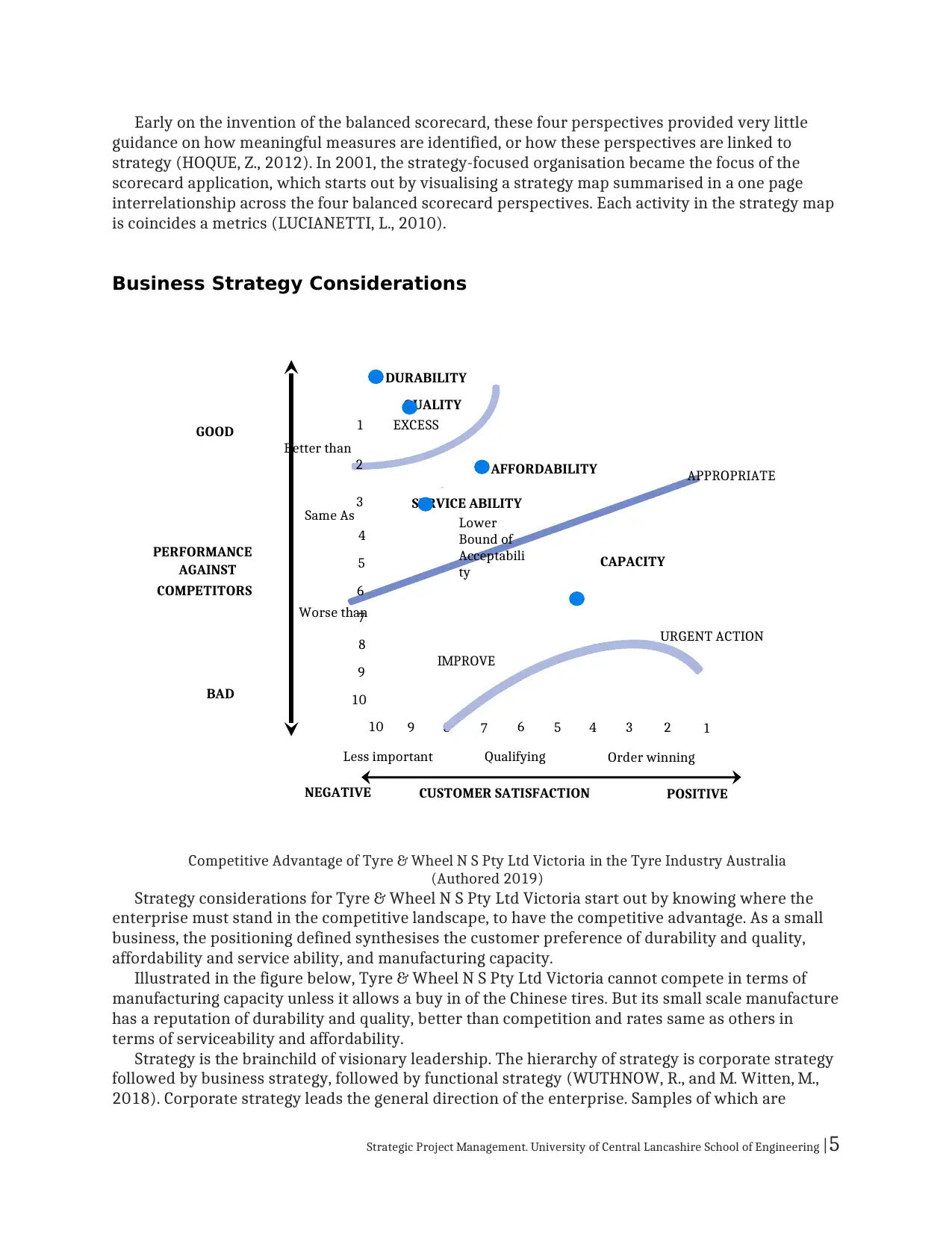
DURABILITY
QUALITY
CAPACITY
AFFORDABILITY
SERVICE ABILITY
EXCESS
APPROPRIATE
IMPROVE
URGENT ACTION
Less important Qualifying Order winning
10 9 8 7
CUSTOMER SATISFACTION POSITIVENEGATIVE
6 5 4 3 2 1
10
9
8
7
6
5
4
3
2
1
PERFORMANCE
AGAINST
COMPETITORS
GOOD
BAD
Better than
Same As
Worse than
Early on the invention of the balanced scorecard, these four perspectives provided very little
guidance on how meaningful measures are identified, or how these perspectives are linked to
strategy (HOQUE, Z., 2012). In 2001, the strategy-focused organisation became the focus of the
scorecard application, which starts out by visualising a strategy map summarised in a one page
interrelationship across the four balanced scorecard perspectives. Each activity in the strategy map
is coincides a metrics (LUCIANETTI, L., 2010).
Business Strategy Considerations
Competitive Advantage of Tyre & Wheel N S Pty Ltd Victoria in the Tyre Industry Australia
(Authored 2019)
Strategy considerations for Tyre & Wheel N S Pty Ltd Victoria start out by knowing where the
enterprise must stand in the competitive landscape, to have the competitive advantage. As a small
business, the positioning defined synthesises the customer preference of durability and quality,
affordability and service ability, and manufacturing capacity.
Illustrated in the figure below, Tyre & Wheel N S Pty Ltd Victoria cannot compete in terms of
manufacturing capacity unless it allows a buy in of the Chinese tires. But its small scale manufacture
has a reputation of durability and quality, better than competition and rates same as others in
terms of serviceability and affordability.
Strategy is the brainchild of visionary leadership. The hierarchy of strategy is corporate strategy
followed by business strategy, followed by functional strategy (WUTHNOW, R., and M. Witten, M.,
2018). Corporate strategy leads the general direction of the enterprise. Samples of which are
Strategic Project Management. University of Central Lancashire School of Engineering |5
Lower
Bound of
Acceptabili
ty
QUALITY
CAPACITY
AFFORDABILITY
SERVICE ABILITY
EXCESS
APPROPRIATE
IMPROVE
URGENT ACTION
Less important Qualifying Order winning
10 9 8 7
CUSTOMER SATISFACTION POSITIVENEGATIVE
6 5 4 3 2 1
10
9
8
7
6
5
4
3
2
1
PERFORMANCE
AGAINST
COMPETITORS
GOOD
BAD
Better than
Same As
Worse than
Early on the invention of the balanced scorecard, these four perspectives provided very little
guidance on how meaningful measures are identified, or how these perspectives are linked to
strategy (HOQUE, Z., 2012). In 2001, the strategy-focused organisation became the focus of the
scorecard application, which starts out by visualising a strategy map summarised in a one page
interrelationship across the four balanced scorecard perspectives. Each activity in the strategy map
is coincides a metrics (LUCIANETTI, L., 2010).
Business Strategy Considerations
Competitive Advantage of Tyre & Wheel N S Pty Ltd Victoria in the Tyre Industry Australia
(Authored 2019)
Strategy considerations for Tyre & Wheel N S Pty Ltd Victoria start out by knowing where the
enterprise must stand in the competitive landscape, to have the competitive advantage. As a small
business, the positioning defined synthesises the customer preference of durability and quality,
affordability and service ability, and manufacturing capacity.
Illustrated in the figure below, Tyre & Wheel N S Pty Ltd Victoria cannot compete in terms of
manufacturing capacity unless it allows a buy in of the Chinese tires. But its small scale manufacture
has a reputation of durability and quality, better than competition and rates same as others in
terms of serviceability and affordability.
Strategy is the brainchild of visionary leadership. The hierarchy of strategy is corporate strategy
followed by business strategy, followed by functional strategy (WUTHNOW, R., and M. Witten, M.,
2018). Corporate strategy leads the general direction of the enterprise. Samples of which are
Strategic Project Management. University of Central Lancashire School of Engineering |5
Lower
Bound of
Acceptabili
ty

strategies for stability, growth or for organisation retrenchment (WALSH, J.P., 2008). Business
strategy is focused on specific industry or market goals that could be competitive for profit oriented
organisations and cooperative strategies for Government or nonprofit organisations. A functional
strategy relates to planning or support infrastructure that enables the business strategy. An
example would be a technological strategy that enables the business strategy (WALTON, R.E., and J.
R. Hackman, 2016).
Affordability
Price sensitivity is an inevitable consideration of the customer. Value for money would mean to
buy cheap but rationally durable products
Capacity
Capacity in the dimension of manufacturing encompasses numerous practices in use, formed
objectives rooted in the production structure; precisely to raise or shrink capacity levels. Paired
with the history of related issues, the volume production as per plant capacity is comparative to
input output performance. Capacity is said to be sustained and predictable. The goal in
manufacturing activities is to enable robust performance described as more output for lesser input
(HINES, P. and Rich, N., 2017).
The concept of capacity with regards to strategy centres on resources of the firm that can define
the competitive advantage. In this case, resources are defined as assets, routines, practices that add
value and non-substitutable since this differentiates itself from its competitors. Lean manufacturing
principles and techniques advance these unique operating capacities, mainly through the
application of resources. Thus capacity recognises intricate set of daily tasks that over the long run
constitute the company core wisdom described as a company secret that is less transferable (LU, X.,
Jia, Z., Yang, J., and Liu, H., 2011).
Durability
Product life is the technical proof of the value of durability, insofar it is economical. A durable
product lasts longer, is slow to deteriorate or expire. As an example, the filament of a light bulb
burns out after so many hours of utilisation, requiring replacement. In other words, repair is
impossible (XIONG, Y. Yan, W., Fernandes, K., Xiong, Z.-K. and N. Guo, 2012) .
For value for money, patrons anticipate the cost of inconvenience in relation to potential
disruptions in the use of the product due to repair. A reliable brands or a model over the long run
saves time and money. With that it is sufficient to state that durability can be defined as the service
life render by the product beforehand it completely breaks down. Reversely, the frequent repair
and malfunction of a product would mean poor durability. (MMUTLE, T., 2017).
A basic inference as regards durability is that durability and reliability are consistent. When
there are faults in a product or end of product life is short, repair and maintenance costs surpass
the cost of a more unfailing, competitive brand or model. Undeniably, a product that is durable has
greater market potential. In fact enterprises encourage consumer satisfaction by offering parts
warranty of a product. Largely, the length of product life is an indicator of quality distinction
(ORAIOPOULOS, N., Ferguson, M.E. and L. B. Toktay, 2012).
Quality
In manufacturing, quality denotes the product key functional characteristics; such as for aircraft
performance: acceleration, handling, cruising speed, glide and comfort; or for audio visual gadgets,
performance is relative to sound and picture clarity, colour, and signal reception capabilities (CAI,
H., Yu, T., and X. Chenglong, 2014).
Strategic Project Management. University of Central Lancashire School of Engineering |6
strategy is focused on specific industry or market goals that could be competitive for profit oriented
organisations and cooperative strategies for Government or nonprofit organisations. A functional
strategy relates to planning or support infrastructure that enables the business strategy. An
example would be a technological strategy that enables the business strategy (WALTON, R.E., and J.
R. Hackman, 2016).
Affordability
Price sensitivity is an inevitable consideration of the customer. Value for money would mean to
buy cheap but rationally durable products
Capacity
Capacity in the dimension of manufacturing encompasses numerous practices in use, formed
objectives rooted in the production structure; precisely to raise or shrink capacity levels. Paired
with the history of related issues, the volume production as per plant capacity is comparative to
input output performance. Capacity is said to be sustained and predictable. The goal in
manufacturing activities is to enable robust performance described as more output for lesser input
(HINES, P. and Rich, N., 2017).
The concept of capacity with regards to strategy centres on resources of the firm that can define
the competitive advantage. In this case, resources are defined as assets, routines, practices that add
value and non-substitutable since this differentiates itself from its competitors. Lean manufacturing
principles and techniques advance these unique operating capacities, mainly through the
application of resources. Thus capacity recognises intricate set of daily tasks that over the long run
constitute the company core wisdom described as a company secret that is less transferable (LU, X.,
Jia, Z., Yang, J., and Liu, H., 2011).
Durability
Product life is the technical proof of the value of durability, insofar it is economical. A durable
product lasts longer, is slow to deteriorate or expire. As an example, the filament of a light bulb
burns out after so many hours of utilisation, requiring replacement. In other words, repair is
impossible (XIONG, Y. Yan, W., Fernandes, K., Xiong, Z.-K. and N. Guo, 2012) .
For value for money, patrons anticipate the cost of inconvenience in relation to potential
disruptions in the use of the product due to repair. A reliable brands or a model over the long run
saves time and money. With that it is sufficient to state that durability can be defined as the service
life render by the product beforehand it completely breaks down. Reversely, the frequent repair
and malfunction of a product would mean poor durability. (MMUTLE, T., 2017).
A basic inference as regards durability is that durability and reliability are consistent. When
there are faults in a product or end of product life is short, repair and maintenance costs surpass
the cost of a more unfailing, competitive brand or model. Undeniably, a product that is durable has
greater market potential. In fact enterprises encourage consumer satisfaction by offering parts
warranty of a product. Largely, the length of product life is an indicator of quality distinction
(ORAIOPOULOS, N., Ferguson, M.E. and L. B. Toktay, 2012).
Quality
In manufacturing, quality denotes the product key functional characteristics; such as for aircraft
performance: acceleration, handling, cruising speed, glide and comfort; or for audio visual gadgets,
performance is relative to sound and picture clarity, colour, and signal reception capabilities (CAI,
H., Yu, T., and X. Chenglong, 2014).
Strategic Project Management. University of Central Lancashire School of Engineering |6
⊘ This is a preview!⊘
Do you want full access?
Subscribe today to unlock all pages.

Trusted by 1+ million students worldwide
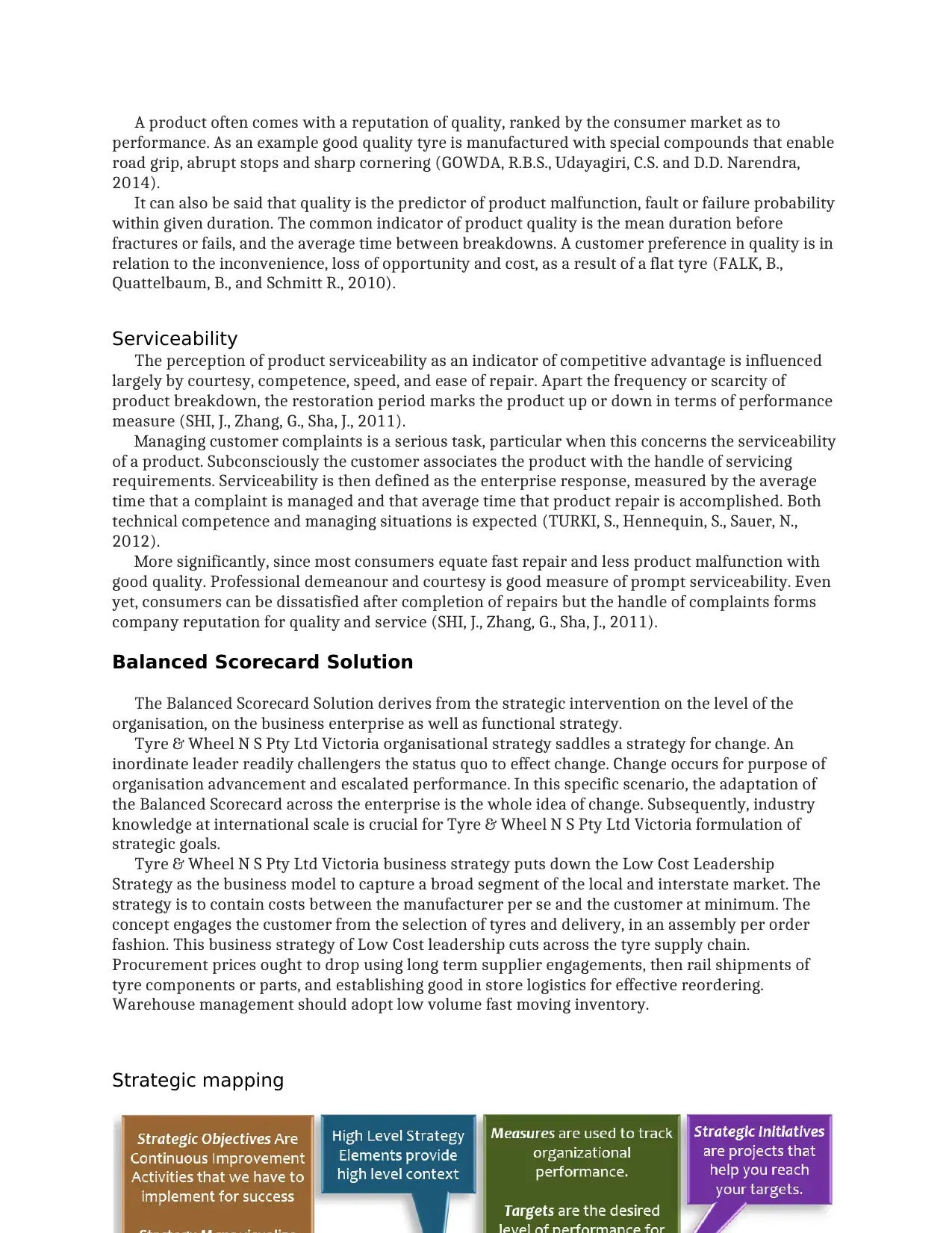
A product often comes with a reputation of quality, ranked by the consumer market as to
performance. As an example good quality tyre is manufactured with special compounds that enable
road grip, abrupt stops and sharp cornering (GOWDA, R.B.S., Udayagiri, C.S. and D.D. Narendra,
2014).
It can also be said that quality is the predictor of product malfunction, fault or failure probability
within given duration. The common indicator of product quality is the mean duration before
fractures or fails, and the average time between breakdowns. A customer preference in quality is in
relation to the inconvenience, loss of opportunity and cost, as a result of a flat tyre (FALK, B.,
Quattelbaum, B., and Schmitt R., 2010).
Serviceability
The perception of product serviceability as an indicator of competitive advantage is influenced
largely by courtesy, competence, speed, and ease of repair. Apart the frequency or scarcity of
product breakdown, the restoration period marks the product up or down in terms of performance
measure (SHI, J., Zhang, G., Sha, J., 2011).
Managing customer complaints is a serious task, particular when this concerns the serviceability
of a product. Subconsciously the customer associates the product with the handle of servicing
requirements. Serviceability is then defined as the enterprise response, measured by the average
time that a complaint is managed and that average time that product repair is accomplished. Both
technical competence and managing situations is expected (TURKI, S., Hennequin, S., Sauer, N.,
2012).
More significantly, since most consumers equate fast repair and less product malfunction with
good quality. Professional demeanour and courtesy is good measure of prompt serviceability. Even
yet, consumers can be dissatisfied after completion of repairs but the handle of complaints forms
company reputation for quality and service (SHI, J., Zhang, G., Sha, J., 2011).
Balanced Scorecard Solution
The Balanced Scorecard Solution derives from the strategic intervention on the level of the
organisation, on the business enterprise as well as functional strategy.
Tyre & Wheel N S Pty Ltd Victoria organisational strategy saddles a strategy for change. An
inordinate leader readily challengers the status quo to effect change. Change occurs for purpose of
organisation advancement and escalated performance. In this specific scenario, the adaptation of
the Balanced Scorecard across the enterprise is the whole idea of change. Subsequently, industry
knowledge at international scale is crucial for Tyre & Wheel N S Pty Ltd Victoria formulation of
strategic goals.
Tyre & Wheel N S Pty Ltd Victoria business strategy puts down the Low Cost Leadership
Strategy as the business model to capture a broad segment of the local and interstate market. The
strategy is to contain costs between the manufacturer per se and the customer at minimum. The
concept engages the customer from the selection of tyres and delivery, in an assembly per order
fashion. This business strategy of Low Cost leadership cuts across the tyre supply chain.
Procurement prices ought to drop using long term supplier engagements, then rail shipments of
tyre components or parts, and establishing good in store logistics for effective reordering.
Warehouse management should adopt low volume fast moving inventory.
Strategic mapping
Strategic Project Management. University of Central Lancashire School of Engineering |7
performance. As an example good quality tyre is manufactured with special compounds that enable
road grip, abrupt stops and sharp cornering (GOWDA, R.B.S., Udayagiri, C.S. and D.D. Narendra,
2014).
It can also be said that quality is the predictor of product malfunction, fault or failure probability
within given duration. The common indicator of product quality is the mean duration before
fractures or fails, and the average time between breakdowns. A customer preference in quality is in
relation to the inconvenience, loss of opportunity and cost, as a result of a flat tyre (FALK, B.,
Quattelbaum, B., and Schmitt R., 2010).
Serviceability
The perception of product serviceability as an indicator of competitive advantage is influenced
largely by courtesy, competence, speed, and ease of repair. Apart the frequency or scarcity of
product breakdown, the restoration period marks the product up or down in terms of performance
measure (SHI, J., Zhang, G., Sha, J., 2011).
Managing customer complaints is a serious task, particular when this concerns the serviceability
of a product. Subconsciously the customer associates the product with the handle of servicing
requirements. Serviceability is then defined as the enterprise response, measured by the average
time that a complaint is managed and that average time that product repair is accomplished. Both
technical competence and managing situations is expected (TURKI, S., Hennequin, S., Sauer, N.,
2012).
More significantly, since most consumers equate fast repair and less product malfunction with
good quality. Professional demeanour and courtesy is good measure of prompt serviceability. Even
yet, consumers can be dissatisfied after completion of repairs but the handle of complaints forms
company reputation for quality and service (SHI, J., Zhang, G., Sha, J., 2011).
Balanced Scorecard Solution
The Balanced Scorecard Solution derives from the strategic intervention on the level of the
organisation, on the business enterprise as well as functional strategy.
Tyre & Wheel N S Pty Ltd Victoria organisational strategy saddles a strategy for change. An
inordinate leader readily challengers the status quo to effect change. Change occurs for purpose of
organisation advancement and escalated performance. In this specific scenario, the adaptation of
the Balanced Scorecard across the enterprise is the whole idea of change. Subsequently, industry
knowledge at international scale is crucial for Tyre & Wheel N S Pty Ltd Victoria formulation of
strategic goals.
Tyre & Wheel N S Pty Ltd Victoria business strategy puts down the Low Cost Leadership
Strategy as the business model to capture a broad segment of the local and interstate market. The
strategy is to contain costs between the manufacturer per se and the customer at minimum. The
concept engages the customer from the selection of tyres and delivery, in an assembly per order
fashion. This business strategy of Low Cost leadership cuts across the tyre supply chain.
Procurement prices ought to drop using long term supplier engagements, then rail shipments of
tyre components or parts, and establishing good in store logistics for effective reordering.
Warehouse management should adopt low volume fast moving inventory.
Strategic mapping
Strategic Project Management. University of Central Lancashire School of Engineering |7
Paraphrase This Document
Need a fresh take? Get an instant paraphrase of this document with our AI Paraphraser
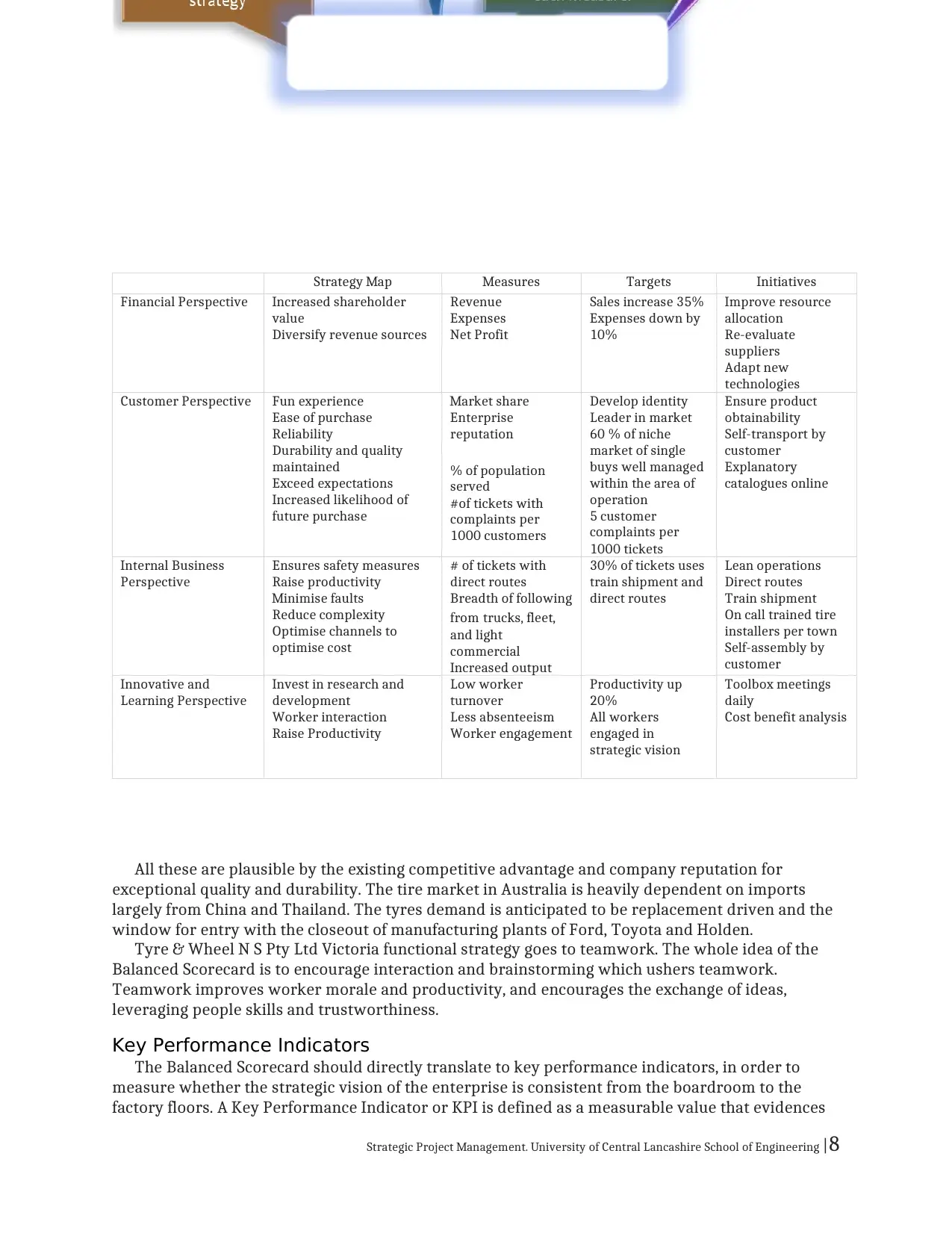
Strategy Map Measures Targets Initiatives
Financial Perspective Increased shareholder
value
Diversify revenue sources
Revenue
Expenses
Net Profit
Sales increase 35%
Expenses down by
10%
Improve resource
allocation
Re-evaluate
suppliers
Adapt new
technologies
Customer Perspective Fun experience
Ease of purchase
Reliability
Durability and quality
maintained
Exceed expectations
Increased likelihood of
future purchase
Market share
Enterprise
reputation
% of population
served
#of tickets with
complaints per
1000 customers
Develop identity
Leader in market
60 % of niche
market of single
buys well managed
within the area of
operation
5 customer
complaints per
1000 tickets
Ensure product
obtainability
Self-transport by
customer
Explanatory
catalogues online
Internal Business
Perspective
Ensures safety measures
Raise productivity
Minimise faults
Reduce complexity
Optimise channels to
optimise cost
# of tickets with
direct routes
Breadth of following
from trucks, fleet,
and light
commercial
Increased output
30% of tickets uses
train shipment and
direct routes
Lean operations
Direct routes
Train shipment
On call trained tire
installers per town
Self-assembly by
customer
Innovative and
Learning Perspective
Invest in research and
development
Worker interaction
Raise Productivity
Low worker
turnover
Less absenteeism
Worker engagement
Productivity up
20%
All workers
engaged in
strategic vision
Toolbox meetings
daily
Cost benefit analysis
All these are plausible by the existing competitive advantage and company reputation for
exceptional quality and durability. The tire market in Australia is heavily dependent on imports
largely from China and Thailand. The tyres demand is anticipated to be replacement driven and the
window for entry with the closeout of manufacturing plants of Ford, Toyota and Holden.
Tyre & Wheel N S Pty Ltd Victoria functional strategy goes to teamwork. The whole idea of the
Balanced Scorecard is to encourage interaction and brainstorming which ushers teamwork.
Teamwork improves worker morale and productivity, and encourages the exchange of ideas,
leveraging people skills and trustworthiness.
Key Performance Indicators
The Balanced Scorecard should directly translate to key performance indicators, in order to
measure whether the strategic vision of the enterprise is consistent from the boardroom to the
factory floors. A Key Performance Indicator or KPI is defined as a measurable value that evidences
Strategic Project Management. University of Central Lancashire School of Engineering |8
LOW COST LEADERSHIP STRATEGY
CHANGE MANAGEMENT FOCUSED ON TEAMWORK
Financial Perspective Increased shareholder
value
Diversify revenue sources
Revenue
Expenses
Net Profit
Sales increase 35%
Expenses down by
10%
Improve resource
allocation
Re-evaluate
suppliers
Adapt new
technologies
Customer Perspective Fun experience
Ease of purchase
Reliability
Durability and quality
maintained
Exceed expectations
Increased likelihood of
future purchase
Market share
Enterprise
reputation
% of population
served
#of tickets with
complaints per
1000 customers
Develop identity
Leader in market
60 % of niche
market of single
buys well managed
within the area of
operation
5 customer
complaints per
1000 tickets
Ensure product
obtainability
Self-transport by
customer
Explanatory
catalogues online
Internal Business
Perspective
Ensures safety measures
Raise productivity
Minimise faults
Reduce complexity
Optimise channels to
optimise cost
# of tickets with
direct routes
Breadth of following
from trucks, fleet,
and light
commercial
Increased output
30% of tickets uses
train shipment and
direct routes
Lean operations
Direct routes
Train shipment
On call trained tire
installers per town
Self-assembly by
customer
Innovative and
Learning Perspective
Invest in research and
development
Worker interaction
Raise Productivity
Low worker
turnover
Less absenteeism
Worker engagement
Productivity up
20%
All workers
engaged in
strategic vision
Toolbox meetings
daily
Cost benefit analysis
All these are plausible by the existing competitive advantage and company reputation for
exceptional quality and durability. The tire market in Australia is heavily dependent on imports
largely from China and Thailand. The tyres demand is anticipated to be replacement driven and the
window for entry with the closeout of manufacturing plants of Ford, Toyota and Holden.
Tyre & Wheel N S Pty Ltd Victoria functional strategy goes to teamwork. The whole idea of the
Balanced Scorecard is to encourage interaction and brainstorming which ushers teamwork.
Teamwork improves worker morale and productivity, and encourages the exchange of ideas,
leveraging people skills and trustworthiness.
Key Performance Indicators
The Balanced Scorecard should directly translate to key performance indicators, in order to
measure whether the strategic vision of the enterprise is consistent from the boardroom to the
factory floors. A Key Performance Indicator or KPI is defined as a measurable value that evidences
Strategic Project Management. University of Central Lancashire School of Engineering |8
LOW COST LEADERSHIP STRATEGY
CHANGE MANAGEMENT FOCUSED ON TEAMWORK

the effective performance of an enterprise particularly in achieving strategic goals. Performance
measures for the evaluation of the company is an important know how in management. The scope
includes the quality of procedure codification, productivity and impact on consumer satisfaction
(CAPPELLI, P. and Tavis. A., 2016).
Adaptability
Ability to learn quickly, can adjust to alterations in job assignment or tasks, method or
surroundings
Quick to catch on new assignments, undisturbed by changes
Accepts change and can fit in to expectations
Learns with difficulty; tends to resist change
Does not grasp or is forgetful of assignments; unaccepting of change
Absenteeism
The number of absence, reports late for duty, duration of lunch break
Outstanding record of attendance and punctuality
Occasionally absent or late
Some problems with attendance, punctuality or misuse of duty hours
Severe case of attendance, punctuality or abuse of duty hours
Company Knowledge
Willingness to support company strategic goals and champions the scorecard
Responds with enthusiasm to company initiatives
Usually responds well to supervision and on occasion takes initiative
Needs prodding; some problems with company initiatives difficulty setting goals
Resents strategic goals has to be monitored and supervised constantly
Innovative and Learning
Expressed interest in professional development and seeks out additional responsibilities;
interested in self- initiating work or ideas
Has mapped out goals which support project or department objectives; self-taught ad
expands knowledge of work
Shows interest and dedication, but needs more careful preparation
Understands self-advancement but takes limited steps on goals and self-advancement
No attempt to hone abilities; no interest in professional development
Customer Orientation
When posed with a problem the ability to develop timely solutions with alternatives
Outstanding analytical and creative abilities and presents with decision superiority
Good cognizance in comparing and contrasting, can evaluate and select right
solutions
Difficulty in recognising problems, lacks creative solutions
Indifferent. Does not concern problems and hesitates to resolve issues
Strategic Project Management. University of Central Lancashire School of Engineering |9
measures for the evaluation of the company is an important know how in management. The scope
includes the quality of procedure codification, productivity and impact on consumer satisfaction
(CAPPELLI, P. and Tavis. A., 2016).
Adaptability
Ability to learn quickly, can adjust to alterations in job assignment or tasks, method or
surroundings
Quick to catch on new assignments, undisturbed by changes
Accepts change and can fit in to expectations
Learns with difficulty; tends to resist change
Does not grasp or is forgetful of assignments; unaccepting of change
Absenteeism
The number of absence, reports late for duty, duration of lunch break
Outstanding record of attendance and punctuality
Occasionally absent or late
Some problems with attendance, punctuality or misuse of duty hours
Severe case of attendance, punctuality or abuse of duty hours
Company Knowledge
Willingness to support company strategic goals and champions the scorecard
Responds with enthusiasm to company initiatives
Usually responds well to supervision and on occasion takes initiative
Needs prodding; some problems with company initiatives difficulty setting goals
Resents strategic goals has to be monitored and supervised constantly
Innovative and Learning
Expressed interest in professional development and seeks out additional responsibilities;
interested in self- initiating work or ideas
Has mapped out goals which support project or department objectives; self-taught ad
expands knowledge of work
Shows interest and dedication, but needs more careful preparation
Understands self-advancement but takes limited steps on goals and self-advancement
No attempt to hone abilities; no interest in professional development
Customer Orientation
When posed with a problem the ability to develop timely solutions with alternatives
Outstanding analytical and creative abilities and presents with decision superiority
Good cognizance in comparing and contrasting, can evaluate and select right
solutions
Difficulty in recognising problems, lacks creative solutions
Indifferent. Does not concern problems and hesitates to resolve issues
Strategic Project Management. University of Central Lancashire School of Engineering |9
⊘ This is a preview!⊘
Do you want full access?
Subscribe today to unlock all pages.

Trusted by 1+ million students worldwide
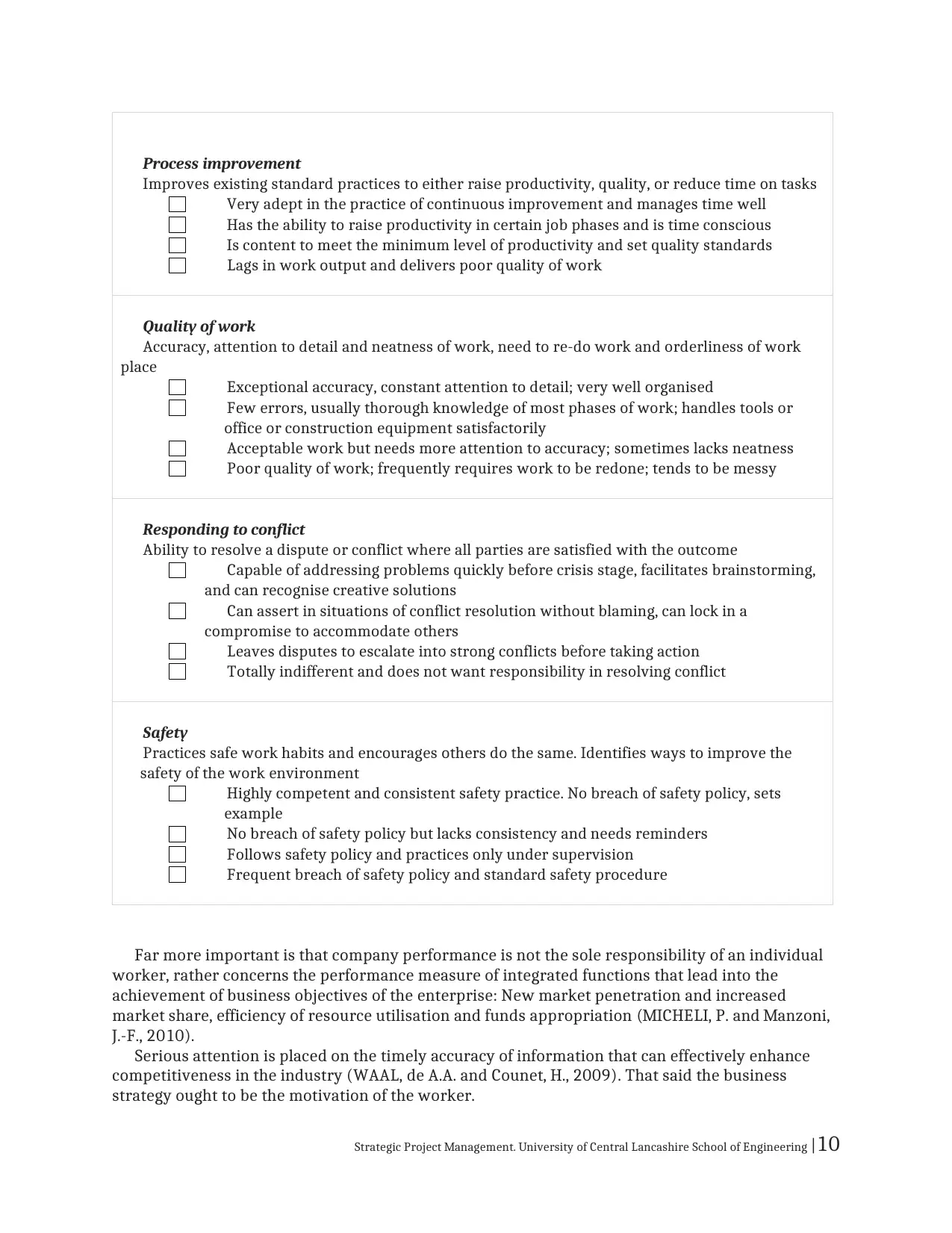
Process improvement
Improves existing standard practices to either raise productivity, quality, or reduce time on tasks
Very adept in the practice of continuous improvement and manages time well
Has the ability to raise productivity in certain job phases and is time conscious
Is content to meet the minimum level of productivity and set quality standards
Lags in work output and delivers poor quality of work
Quality of work
Accuracy, attention to detail and neatness of work, need to re-do work and orderliness of work
place
Exceptional accuracy, constant attention to detail; very well organised
Few errors, usually thorough knowledge of most phases of work; handles tools or
office or construction equipment satisfactorily
Acceptable work but needs more attention to accuracy; sometimes lacks neatness
Poor quality of work; frequently requires work to be redone; tends to be messy
Responding to conflict
Ability to resolve a dispute or conflict where all parties are satisfied with the outcome
Capable of addressing problems quickly before crisis stage, facilitates brainstorming,
and can recognise creative solutions
Can assert in situations of conflict resolution without blaming, can lock in a
compromise to accommodate others
Leaves disputes to escalate into strong conflicts before taking action
Totally indifferent and does not want responsibility in resolving conflict
Safety
Practices safe work habits and encourages others do the same. Identifies ways to improve the
safety of the work environment
Highly competent and consistent safety practice. No breach of safety policy, sets
example
No breach of safety policy but lacks consistency and needs reminders
Follows safety policy and practices only under supervision
Frequent breach of safety policy and standard safety procedure
Far more important is that company performance is not the sole responsibility of an individual
worker, rather concerns the performance measure of integrated functions that lead into the
achievement of business objectives of the enterprise: New market penetration and increased
market share, efficiency of resource utilisation and funds appropriation (MICHELI, P. and Manzoni,
J.-F., 2010).
Serious attention is placed on the timely accuracy of information that can effectively enhance
competitiveness in the industry (WAAL, de A.A. and Counet, H., 2009). That said the business
strategy ought to be the motivation of the worker.
Strategic Project Management. University of Central Lancashire School of Engineering |10
Improves existing standard practices to either raise productivity, quality, or reduce time on tasks
Very adept in the practice of continuous improvement and manages time well
Has the ability to raise productivity in certain job phases and is time conscious
Is content to meet the minimum level of productivity and set quality standards
Lags in work output and delivers poor quality of work
Quality of work
Accuracy, attention to detail and neatness of work, need to re-do work and orderliness of work
place
Exceptional accuracy, constant attention to detail; very well organised
Few errors, usually thorough knowledge of most phases of work; handles tools or
office or construction equipment satisfactorily
Acceptable work but needs more attention to accuracy; sometimes lacks neatness
Poor quality of work; frequently requires work to be redone; tends to be messy
Responding to conflict
Ability to resolve a dispute or conflict where all parties are satisfied with the outcome
Capable of addressing problems quickly before crisis stage, facilitates brainstorming,
and can recognise creative solutions
Can assert in situations of conflict resolution without blaming, can lock in a
compromise to accommodate others
Leaves disputes to escalate into strong conflicts before taking action
Totally indifferent and does not want responsibility in resolving conflict
Safety
Practices safe work habits and encourages others do the same. Identifies ways to improve the
safety of the work environment
Highly competent and consistent safety practice. No breach of safety policy, sets
example
No breach of safety policy but lacks consistency and needs reminders
Follows safety policy and practices only under supervision
Frequent breach of safety policy and standard safety procedure
Far more important is that company performance is not the sole responsibility of an individual
worker, rather concerns the performance measure of integrated functions that lead into the
achievement of business objectives of the enterprise: New market penetration and increased
market share, efficiency of resource utilisation and funds appropriation (MICHELI, P. and Manzoni,
J.-F., 2010).
Serious attention is placed on the timely accuracy of information that can effectively enhance
competitiveness in the industry (WAAL, de A.A. and Counet, H., 2009). That said the business
strategy ought to be the motivation of the worker.
Strategic Project Management. University of Central Lancashire School of Engineering |10
Paraphrase This Document
Need a fresh take? Get an instant paraphrase of this document with our AI Paraphraser
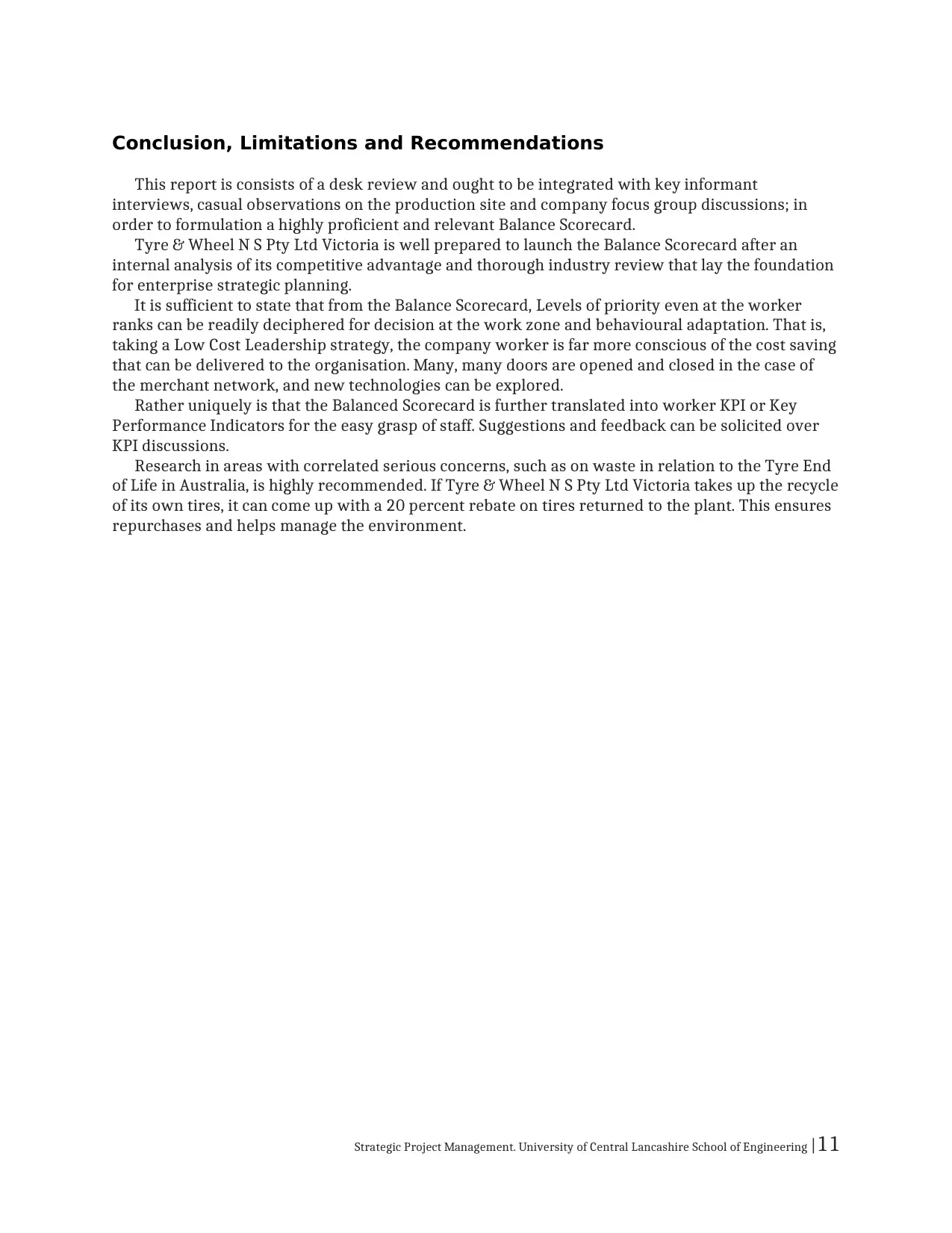
Conclusion, Limitations and Recommendations
This report is consists of a desk review and ought to be integrated with key informant
interviews, casual observations on the production site and company focus group discussions; in
order to formulation a highly proficient and relevant Balance Scorecard.
Tyre & Wheel N S Pty Ltd Victoria is well prepared to launch the Balance Scorecard after an
internal analysis of its competitive advantage and thorough industry review that lay the foundation
for enterprise strategic planning.
It is sufficient to state that from the Balance Scorecard, Levels of priority even at the worker
ranks can be readily deciphered for decision at the work zone and behavioural adaptation. That is,
taking a Low Cost Leadership strategy, the company worker is far more conscious of the cost saving
that can be delivered to the organisation. Many, many doors are opened and closed in the case of
the merchant network, and new technologies can be explored.
Rather uniquely is that the Balanced Scorecard is further translated into worker KPI or Key
Performance Indicators for the easy grasp of staff. Suggestions and feedback can be solicited over
KPI discussions.
Research in areas with correlated serious concerns, such as on waste in relation to the Tyre End
of Life in Australia, is highly recommended. If Tyre & Wheel N S Pty Ltd Victoria takes up the recycle
of its own tires, it can come up with a 20 percent rebate on tires returned to the plant. This ensures
repurchases and helps manage the environment.
Strategic Project Management. University of Central Lancashire School of Engineering |11
This report is consists of a desk review and ought to be integrated with key informant
interviews, casual observations on the production site and company focus group discussions; in
order to formulation a highly proficient and relevant Balance Scorecard.
Tyre & Wheel N S Pty Ltd Victoria is well prepared to launch the Balance Scorecard after an
internal analysis of its competitive advantage and thorough industry review that lay the foundation
for enterprise strategic planning.
It is sufficient to state that from the Balance Scorecard, Levels of priority even at the worker
ranks can be readily deciphered for decision at the work zone and behavioural adaptation. That is,
taking a Low Cost Leadership strategy, the company worker is far more conscious of the cost saving
that can be delivered to the organisation. Many, many doors are opened and closed in the case of
the merchant network, and new technologies can be explored.
Rather uniquely is that the Balanced Scorecard is further translated into worker KPI or Key
Performance Indicators for the easy grasp of staff. Suggestions and feedback can be solicited over
KPI discussions.
Research in areas with correlated serious concerns, such as on waste in relation to the Tyre End
of Life in Australia, is highly recommended. If Tyre & Wheel N S Pty Ltd Victoria takes up the recycle
of its own tires, it can come up with a 20 percent rebate on tires returned to the plant. This ensures
repurchases and helps manage the environment.
Strategic Project Management. University of Central Lancashire School of Engineering |11
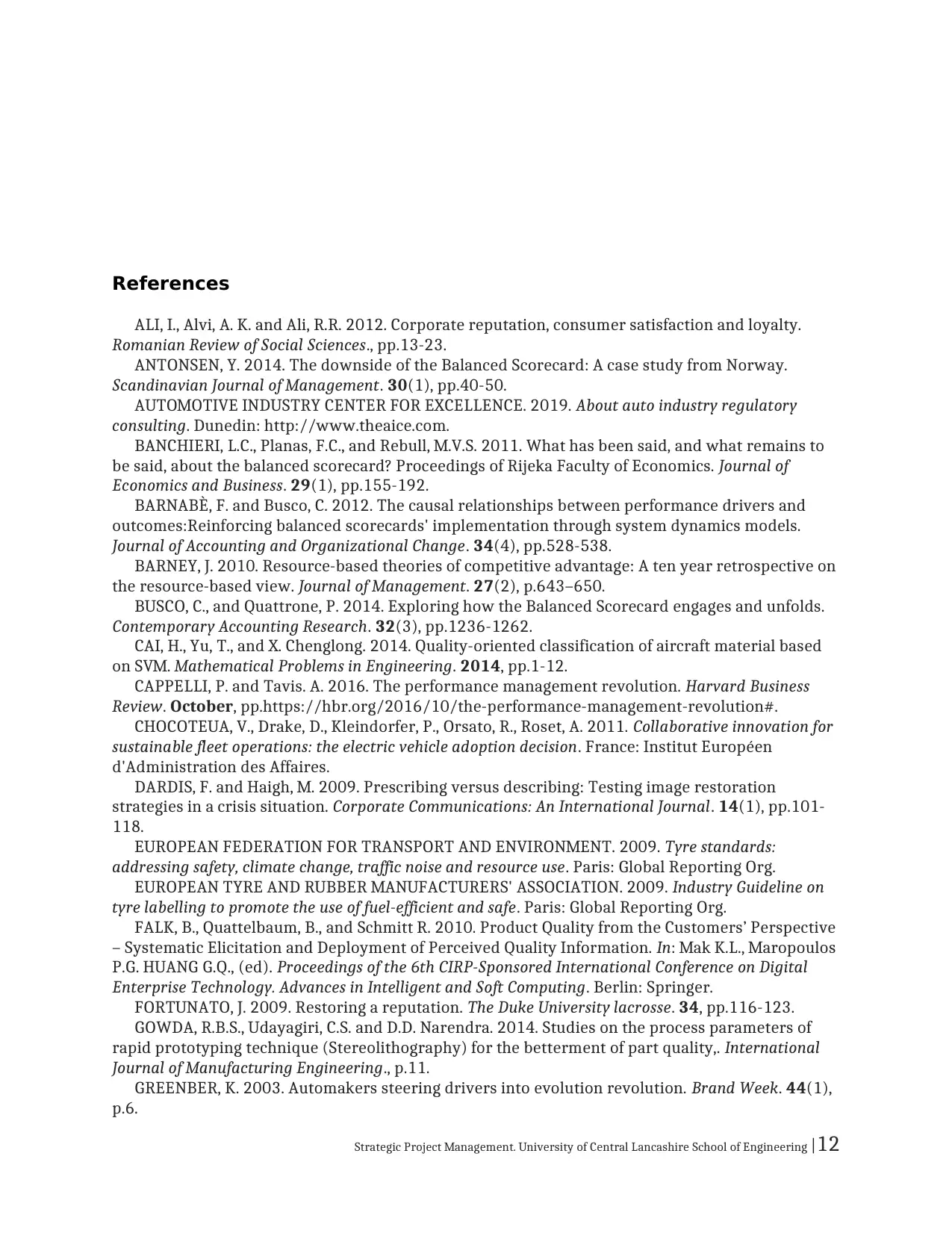
References
ALI, I., Alvi, A. K. and Ali, R.R. 2012. Corporate reputation, consumer satisfaction and loyalty.
Romanian Review of Social Sciences., pp.13-23.
ANTONSEN, Y. 2014. The downside of the Balanced Scorecard: A case study from Norway.
Scandinavian Journal of Management. 30(1), pp.40-50.
AUTOMOTIVE INDUSTRY CENTER FOR EXCELLENCE. 2019. About auto industry regulatory
consulting. Dunedin: http://www.theaice.com.
BANCHIERI, L.C., Planas, F.C., and Rebull, M.V.S. 2011. What has been said, and what remains to
be said, about the balanced scorecard? Proceedings of Rijeka Faculty of Economics. Journal of
Economics and Business. 29(1), pp.155-192.
BARNABÈ, F. and Busco, C. 2012. The causal relationships between performance drivers and
outcomes:Reinforcing balanced scorecards' implementation through system dynamics models.
Journal of Accounting and Organizational Change. 34(4), pp.528-538.
BARNEY, J. 2010. Resource-based theories of competitive advantage: A ten year retrospective on
the resource-based view. Journal of Management. 27(2), p.643–650.
BUSCO, C., and Quattrone, P. 2014. Exploring how the Balanced Scorecard engages and unfolds.
Contemporary Accounting Research. 32(3), pp.1236-1262.
CAI, H., Yu, T., and X. Chenglong. 2014. Quality-oriented classification of aircraft material based
on SVM. Mathematical Problems in Engineering. 2014, pp.1-12.
CAPPELLI, P. and Tavis. A. 2016. The performance management revolution. Harvard Business
Review. October, pp.https://hbr.org/2016/10/the-performance-management-revolution#.
CHOCOTEUA, V., Drake, D., Kleindorfer, P., Orsato, R., Roset, A. 2011. Collaborative innovation for
sustainable fleet operations: the electric vehicle adoption decision. France: Institut Européen
d'Administration des Affaires.
DARDIS, F. and Haigh, M. 2009. Prescribing versus describing: Testing image restoration
strategies in a crisis situation. Corporate Communications: An International Journal. 14(1), pp.101-
118.
EUROPEAN FEDERATION FOR TRANSPORT AND ENVIRONMENT. 2009. Tyre standards:
addressing safety, climate change, traffic noise and resource use. Paris: Global Reporting Org.
EUROPEAN TYRE AND RUBBER MANUFACTURERS' ASSOCIATION. 2009. Industry Guideline on
tyre labelling to promote the use of fuel-efficient and safe. Paris: Global Reporting Org.
FALK, B., Quattelbaum, B., and Schmitt R. 2010. Product Quality from the Customers’ Perspective
– Systematic Elicitation and Deployment of Perceived Quality Information. In: Mak K.L., Maropoulos
P.G. HUANG G.Q., (ed). Proceedings of the 6th CIRP-Sponsored International Conference on Digital
Enterprise Technology. Advances in Intelligent and Soft Computing. Berlin: Springer.
FORTUNATO, J. 2009. Restoring a reputation. The Duke University lacrosse. 34, pp.116-123.
GOWDA, R.B.S., Udayagiri, C.S. and D.D. Narendra. 2014. Studies on the process parameters of
rapid prototyping technique (Stereolithography) for the betterment of part quality,. International
Journal of Manufacturing Engineering., p.11.
GREENBER, K. 2003. Automakers steering drivers into evolution revolution. Brand Week. 44(1),
p.6.
Strategic Project Management. University of Central Lancashire School of Engineering |12
ALI, I., Alvi, A. K. and Ali, R.R. 2012. Corporate reputation, consumer satisfaction and loyalty.
Romanian Review of Social Sciences., pp.13-23.
ANTONSEN, Y. 2014. The downside of the Balanced Scorecard: A case study from Norway.
Scandinavian Journal of Management. 30(1), pp.40-50.
AUTOMOTIVE INDUSTRY CENTER FOR EXCELLENCE. 2019. About auto industry regulatory
consulting. Dunedin: http://www.theaice.com.
BANCHIERI, L.C., Planas, F.C., and Rebull, M.V.S. 2011. What has been said, and what remains to
be said, about the balanced scorecard? Proceedings of Rijeka Faculty of Economics. Journal of
Economics and Business. 29(1), pp.155-192.
BARNABÈ, F. and Busco, C. 2012. The causal relationships between performance drivers and
outcomes:Reinforcing balanced scorecards' implementation through system dynamics models.
Journal of Accounting and Organizational Change. 34(4), pp.528-538.
BARNEY, J. 2010. Resource-based theories of competitive advantage: A ten year retrospective on
the resource-based view. Journal of Management. 27(2), p.643–650.
BUSCO, C., and Quattrone, P. 2014. Exploring how the Balanced Scorecard engages and unfolds.
Contemporary Accounting Research. 32(3), pp.1236-1262.
CAI, H., Yu, T., and X. Chenglong. 2014. Quality-oriented classification of aircraft material based
on SVM. Mathematical Problems in Engineering. 2014, pp.1-12.
CAPPELLI, P. and Tavis. A. 2016. The performance management revolution. Harvard Business
Review. October, pp.https://hbr.org/2016/10/the-performance-management-revolution#.
CHOCOTEUA, V., Drake, D., Kleindorfer, P., Orsato, R., Roset, A. 2011. Collaborative innovation for
sustainable fleet operations: the electric vehicle adoption decision. France: Institut Européen
d'Administration des Affaires.
DARDIS, F. and Haigh, M. 2009. Prescribing versus describing: Testing image restoration
strategies in a crisis situation. Corporate Communications: An International Journal. 14(1), pp.101-
118.
EUROPEAN FEDERATION FOR TRANSPORT AND ENVIRONMENT. 2009. Tyre standards:
addressing safety, climate change, traffic noise and resource use. Paris: Global Reporting Org.
EUROPEAN TYRE AND RUBBER MANUFACTURERS' ASSOCIATION. 2009. Industry Guideline on
tyre labelling to promote the use of fuel-efficient and safe. Paris: Global Reporting Org.
FALK, B., Quattelbaum, B., and Schmitt R. 2010. Product Quality from the Customers’ Perspective
– Systematic Elicitation and Deployment of Perceived Quality Information. In: Mak K.L., Maropoulos
P.G. HUANG G.Q., (ed). Proceedings of the 6th CIRP-Sponsored International Conference on Digital
Enterprise Technology. Advances in Intelligent and Soft Computing. Berlin: Springer.
FORTUNATO, J. 2009. Restoring a reputation. The Duke University lacrosse. 34, pp.116-123.
GOWDA, R.B.S., Udayagiri, C.S. and D.D. Narendra. 2014. Studies on the process parameters of
rapid prototyping technique (Stereolithography) for the betterment of part quality,. International
Journal of Manufacturing Engineering., p.11.
GREENBER, K. 2003. Automakers steering drivers into evolution revolution. Brand Week. 44(1),
p.6.
Strategic Project Management. University of Central Lancashire School of Engineering |12
⊘ This is a preview!⊘
Do you want full access?
Subscribe today to unlock all pages.

Trusted by 1+ million students worldwide
1 out of 14
Your All-in-One AI-Powered Toolkit for Academic Success.
+13062052269
info@desklib.com
Available 24*7 on WhatsApp / Email
![[object Object]](/_next/static/media/star-bottom.7253800d.svg)
Unlock your academic potential
Copyright © 2020–2025 A2Z Services. All Rights Reserved. Developed and managed by ZUCOL.